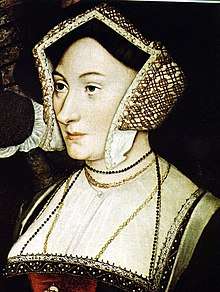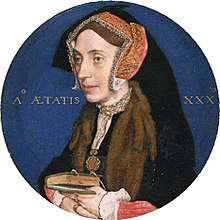Margaret Roper
| Margaret Roper, Lady Roper | |
|---|---|
 Portrait of Margaret Roper, from a 1593 reproduction of a now-lost Hans Holbein portrait of all of the women of Thomas More's family. | |
| Born |
Margaret More 1505 Bucklersbury, London |
| Died |
1544 Chelsea, London |
| Resting place | St. Dunstan's, Canterbury |
| Spouse | |
| Children |
Elizabeth Margaret Thomas Mary Anthony |
| Relatives | Thomas More (father) |
Margaret Roper (1505–1544) was an English writer and translator. Roper, the eldest daughter of Sir Thomas More, is considered as one of the most learned women of sixteenth-century England.[1] She is celebrated for her filial piety and scholastic acquirements.[2] Roper's most known publication is a Latin-to-English translation of Erasmus' Precatio Dominica as A Devout Treatise upon the Paternoster.[3] In addition, she wrote many Latin epistles and English letters, as well as an original treatise entitled The Four Last Things. She also translated the Ecclesiastical History of Eusebius from the Greek into the Latin language.[4]
Early life
Margaret More was the eldest child of Sir Thomas More and Joanna "Jane" Colt. Colt the daughter of an Essex gentleman and died of unknown causes in 1511.[5] Margaret was most likely baptized at St. Stephen's Church, across the street from the More's family home. Besides Margaret, Joanna had three other children: Elizabeth, Cecily, and John. In addition, soon after Margaret's birth, the More family adopted Margaret Giggs, the daughter of a recently deceased neighbor.[6]
After the death of Colt, More married Alice Middleton, a widow. More's marriage to Middleton came with a step-sister for Margaret and her siblings, named Alice after her mother. However, Middleton bore no children with More.[3] Roper spent most her childhood at the Barge at Bucklersbury. In 1524, the Ropers and Mores moved to Butts Close a home in Chelsea, Middlesex.[6] It was a large and commodious mansion opposite to Thames, built by Sir Thomas More on the site subsequently occupied by Beaufort House.[7] There, Erasmus, a close friend of More, passed many happy days, and Hans Holbein the Younger painted some of his finest pictures.[4]
Roper gave early indications of extraordinary intellectual abilities, deep devotion to God, and is cited as having "the most amiable and affectionate disposition".[4] She and her siblings were educated in the humanist tradition by her father and tutor William Gunnell. Roper was proficient in Greek and Latin, prose and verse, philosophy and history, and had a thorough knowledge of music, arithmetic, and some other sciences.[2] In his letters, More makes clear his desire to educate his daughters as much as his sons.[6][8] In his children's studies, More emphasized translations as the best way to teach language thus facilitating Roper's experience and later work with translations. More advocated for the education of girls, but within certain limits, for example that any work they complete should remain within the private sphere.[9]
Personal life
Margaret married William Roper in 1521 in Eltham, Kent, and they made their home at Well Hall in Eltham.[10] She was, like the rest of her family, a sincere adherent to the tenets of the Roman Catholic Church, and, having married William, a Lutheran, is said to have converted him back to the religion of his fathers. William was the son of John Roper, Esq. prothonotary of the King's Bench, and possessor of an estate at Eltham in Kent.[2] Roper and her husband had five children: Elizabeth (1523–60), Margaret (1526–88), Thomas (1533–98), Mary (d. 1572), and Anthony (1544–1597). Roper's third daughter, Mary, is known for her translation work, as well.[11] William Roper ("son Roper," as he is referred to by Thomas More) produced the first biography of the statesman, but his homage to his father-in-law is not remembered as well as his wife's efforts.[12] William Roper's biography of More is given weight due to his role as a witness in Henry VIII and More's famous disagreement.[5]
Career
Roper was the first non-royal woman to publish a translation.[8] This was her translation of the Latin work, Precatio Dominica by Erasmus, as A Devout Treatise upon the Paternoster. Erasmus was sufficiently impressed with her skills and dedicated his Commentary on the Christian hymn of Prudentius (1523) to her.[1] Erasmus is cited as writing most of his work, The Praise of Folly, during a visit to Bucklersbury. The dedication to The Praise of Folly cites Thomas More and his friendship with Erasmus heavily.[6] In 1524, Roper also completed a translation of Erasmus' thoughts on the Lord's Prayer.
In a letter, Roper mentions her poems, but none are extant.[1] Lost work of Roper's also include her Latin and Greek verses, Latin speeches, her imitation of Quintilian, and her treatise, The Four Laste Thynges.[8]


Significance of work
Roper's translations can be seen as a contribution to a contemporary debate between the Catholics and the Protestants. Jaime Goodrich, author of Faithful Translators: Authorship, Gender, and Religion in Early Modern England, explores this relationship with Roper's translation work. In the midst of the discourse on Erasmus over whether he supported or refuted the spread of Lutheranism, Roper's translation of Erasmus' A Devout Treatise upon the Paternoster was viewed with scrutiny and used as evidence that English authorities supported Erasmus.[9]
Relationship with Thomas More
Roper's relationship with her father, Thomas More is renowned and often cited as an example of familial loyalty. More often refers to Roper as "My dearest Meg".[6]
Roper visited More often during his imprisonment in the Tower of London. Thomas Cromwell allowed the visitations in hopes that Roper would persuade More to accept the Acts of Supremacy avoid execution. During her visits, Roper smuggled letters and other things to and from More.[5] Roper is credited with putting together a dossier of the letters written by More during his time in the tower.[6]
After Thomas More was beheaded in 1535 for his refusal to accept the Acts of Supremacy and the Act of Succession (1534) of Henry VIII of England and swear allegiance to Henry as head of the English Church, his head was displayed on a pike at London Bridge for a month. Roper bribed the man whose business it was to throw the head into the river to give it to her instead. She preserved it by pickling it in spices until her own death at the age of 39 in 1544. After her death, William Roper took charge of the head, and it is buried with him.[3][13]
More and his relatives were branded traitors following his execution. Roper took steps to clear her father's name posthumously by hiring More's old secretary John Harris to collect and recreate his writings to prove that there is no evidence of treason found within them.[5]
Death
Roper died in 1544 and was buried in Chelsea Parish Church, "possibly with her father's head".[3] Her husband, who survived her thirty-three years, never remarried and honored her memory by living a life devoted to learning, beneficence, and piety.[4] Following her husband's death, Roper was reinterred in the vault belonging to the family of Roper, in St. Dunstan's, Canterbury.[3]
In popular culture
In Alfred, Lord Tennyson's Dream of Fair Women, he invokes Margaret Roper ("who clasped in her last trance/ Her murdered father's head") as a paragon of loyalty and familial love.
In Robert Bolt's famous play A Man for All Seasons, Margaret and William Roper were major characters. Bolt characterizes Roper as a brilliant and strong unmarried woman in her twenties.[8] In the 1966 film, she was portrayed by Susannah York. However is this portrayal she is only shown in scenes of domesticity and her unwavering moral support of her father is not highlighted.[6]
In the 2007 TV show The Tudors which focuses on the reign of Henry VIII, Margaret Roper is portrayed by actress Gemma Reeves. The show focuses some on More's conflict with Henry VIII.
Legacy
However in some works mentioning Roper, such as the official Catholic biography on her by Nicholas Harpsfield, Roper was often omitted from the narrative as her influence and relationship with More took away from his identity as a martyr for Catholicism.[6]
References
- 1 2 3 Jones, Mike Rodman. "Roper, Margaret", The Encyclopedia of English Renaissance Literature, (Garrett A. Sullivan, Jr. and Alan Stewart, eds.), Blackwell, 2012, DOI:10.1111/b.9781405194495.2012.x
- 1 2 3 Caldesi 1864, p. 79.
- 1 2 3 4 5 "Roper [née More], Margaret (1505–1544), scholar and daughter of Sir Thomas More | Oxford Dictionary of National Biography". doi:10.1093/ref:odnb/9780198614128.001.0001/odnb-9780198614128-e-24071#odnb-9780198614128-e-24071.
- 1 2 3 4 Williams (called Ysgafell.) 1861, p. 41.
- 1 2 3 4 Guy, John (2017). Thomas More. London: Society for Promoting Christian Knowledge. ISBN 9780281076185.
- 1 2 3 4 5 6 7 8 Alexander), Guy, J. A. (John (2009). A daughter's love : Thomas More and his dearest Meg. Boston: Houghton Mifflin Harcourt. ISBN 9780618499151. OCLC 231588340.
- ↑ Cave & Nichols 1829, p. 497.
- 1 2 3 4 "WWR Magazine" (PDF). Margaret Roper and Erasmus: The Relationship of Translator and Source. CRC Humanities Computing Studio, located at the University of Alberta. Retrieved 15 August 2011.
- 1 2 Goodrich, Jaime (2014). Faithful Translators: Authorship, Gender, and Religion in Early Modern England. Evanston, Illinois: Northwestern University Press. pp. 34–50. ISBN 9780810129382.
- ↑ Daniel Lysons, Eltham entry, in The Environs of London: Volume 4, Counties of Herts, Essex and Kent (London, 1796), pp. 394-421. [accessed 26 May 2017]. from British History Online ()
- ↑ Bowden, Caroline M. K. "Bassett [née Roper], Mary (d. 1572), translator, Oxford Dictionary of National Biography". Retrieved 2018-05-04.
- ↑ "Roper, William (1495x8–1578), biographer | Oxford Dictionary of National Biography". doi:10.1093/ref:odnb/9780198614128.001.0001/odnb-9780198614128-e-24074.
- ↑ Goodrich, Jaime (2008). "Thomas More and Margaret More Roper: A Case for Rethinking Women's Participation in the Early Modern Public Sphere". The Sixteenth Century Journal. 39 (4): 1021–1040. doi:10.2307/20479136. JSTOR 20479136.
Bibliography



External links
- Works by or about Margaret Roper at Internet Archive
- Patricia Demers: "Margaret Roper and Erasmus: the Relationship of Translator and Source," WWR Magazine, Spring 2005.
- Works by or about Margaret Roper in libraries (WorldCat catalog)
- "Letter to Margaret Roper written by Thomas More the day before his execution"
- Project Continua: Biography of Margaret More Roper Project Continua is a web-based multimedia resource dedicated to the creation and preservation of women’s intellectual history from the earliest surviving evidence into the 21st century.
- Roper's translation of Erasmus